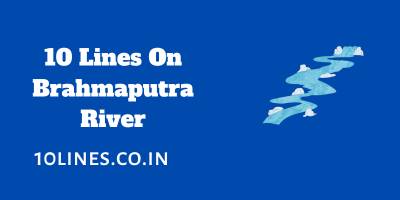10 Lines On Brahmaputra River Do you need a ten-line essay on India’s famous river Brahmaputra? Here you will get three different essays on the Brahmaputra River for different categories of students. The three categories are based on the level of comprehension of Children, schoolchildren, and high school students.

10 Lines On Brahmaputra River For Children And Students
You can learn about the Brahmaputra’s origin, length, tributary rivers, cultural significance, and many other things here.
The Brahmaputra is a transboundary river that flows through three distinct nations and is fed by melting Himalayan glaciers. The people who live close to the river basin are greatly impacted by this prominent river. It is a significant contributor to the Ganges River and has its origins in Tibet.
To learn more about the revered river Brahmaputra, it is advised to read the entire article.
Set 1] 10 Lines On The Brahmaputra River For Children:
1] Brahmaputra is an Asian river that flows across Tibet, Northern India, and Bangladesh.
2] The river is 3,969 kilometres long, making it Asia’s sixth longest river.
3] Brahmaputra is a Sanskrit term that means “son of Lord Bramha.”
4] The Brahmaputra River basin covers 651 334 km2, with the majority of it being in Tibet.
5] Brahmaputra River has a 5.46 Kilometre average width.
6] The river is known as the “Brahmaputra” after its confluence with the Lohit River.
7] The Brahmaputra River, which may reach depths of 380 feet, is the deepest river in India.
8] The Brahmaputra River is also home to many unique tourist spots, making it a great destination for travellers.
9] The river Brahmaputra has significant religious significance because of Kailash-Manasarowar.
10] In the region where it flows, the Brahmaputra is a significant river for irrigation and transportation.
Set 2] 10 Lines On The Brahmaputra River For School Students:
1] The Brahmaputra River runs through Tibet, Northern India, and Bangladesh.
2] The Brahmaputra River has a maximum depth of 135 m and an average depth of 30 m.
3] The Kubi, Angsi, and Chemayungdung are the three headstreams that compose the Brahmaputra.
4] The Brahmaputra River traverses the Indian states of Arunachal Pradesh, West Bengal, Assam, Meghalaya, Nagaland, and Sikkim.
5] The river is known as the “Yarlung Tsangpo” within the Tibetan Autonomous Region.
6] The Brahmaputra River meets India’s greatest river, the Ganga, in Bangladesh.
7] There are 33 major tributaries in India, 33 major tributaries in Tibet, and 3 major rivers in Bangladesh that feed into the Brahmaputra.
8] The “Brahmaputra” is recognized as the only “male” river in Hinduism and is thought to be the “Son of Lord Brahma.”
9] The river is fed by Melting glaciers during the summer months which is followed by heavy monsoons. Due to this, the Brahmaputra river naturally overflows during this period.
10] Many million Indian and Bangladeshi people rely on the Brahmaputra River, making it a lifeline for them.
Set 3] 10 Lines On The Brahmaputra River For College Students:
1] Brahmaputra River begins in the Chemayungdung Glacier in Mount Kailash’s range and flows for more than 3,969 kilometres.
2] The river is also known as the Tsangpo-Brahmaputra in Tibet, China’s autonomous region.
3] Brahmaputra’s basin spans 2, 93,000 sq.km in Tibet, 2,40,000 sq.km in India and 47,000 sq.km in Bangladesh.
4] The Brahmaputra River is also referred to as the Red River because of its high concentration of red and yellow soil deposits.
5] The Brahmaputra’s water quality is appropriate for human consumption, irrigation use, and routine home tasks.
6] Majuli Island, which is thought to be the largest riverine island in the world, was created by the Brahmaputra.
7] The Chemayungdung Glacier in the Kailash Range, at an elevation of 5300 metres, is the source of the Brahmaputra.
8] Dibrugarh, Jorhat, Tezpur, Guwahati, Dhubri, and Sirajganj are some of the important cities along the Brahmaputra River.
9] Red loamy soil and alluvial soil are the two soil types that are most frequently seen in the Brahmaputra subbasin.
10] The Himalayan snowmelt and heavy rains are the main causes of the Brahmaputra River’s flooding.
Readers, thank you for reading “10 Lines on the Brahmaputra.” We sincerely hope that the data above is useful to you. This information was presented in an effort to be clear and simple to remember. You can use this information in your projects, homework preparation, and presentations.